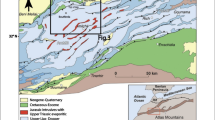Abstract
A vector model of the relationship between geosystems and the geographical environment is proposed. Based on Gauss’s principle of least constraint (deviation), a representation of a geosystem is formed as a set (layer) of changed states that differ minimally from the invariant characteristics of the state of the corresponding environment. The geographical environment as a diversity (manifold) of terrestrial environment has a relief expression in the form of an integrating and evaluation function of many variables. Geographical characteristics of geosystems consist of a constant environment-dependent vector component and a free vector of azonal factor variability, which expresses the measure of constraint (nondeterminism). Minimization of this vector relative to the elements of the environment’s diversity leads to differential equations of the vector geosystem field: a representation of geographical data and knowledge in the space of characteristics that locally has a universal symmetry, which allows us to compare geographical processes and phenomena on a single basis. The resulting relations are explained by the properties of the known geographical models and concepts that are in a dual relationship: objects and subjects of research, factors and conditions of influence, laws and regularities of interaction, and so on. External (exo-) and internal (endo-) environments are selected and taken into account when calculating the equations. The results are illustrated based on the example of preformation of spatial information obtained by the method of complex ordination, with verification of the hypothesis of environmental homogeneity and territorial integrity of dark coniferous taiga sites at different stages of endogenous dynamics of facies of a subhydromorphic factor series. It is concluded that the relationships of geosystems and their endo- and exo-environments should be taken into account when processing landscape research data, mathematical modeling, and synthetic mapping of territories.



Similar content being viewed by others
REFERENCES
Sochava, B.V., Vvedenie v uchenie o geosistemakh (Introduction to the Theory of Geosystems), Novosibirsk: Nauka, 1978.
Semenov, Yu.M. and Suvorov, E.G., Geosystems and complex physical geography, Geogr. Prir. Resur., 2007, no. 3, pp. 11–19.
Markov, Yu.G., Funktsional’nyi podkhod v sovremennom nauchnom poznanii (The Functional Approach in Modern Scientific Knowledge), Novosibirsk: Nauka, 1982.
Mezhdistsiplinarnye problemy sredovogo podkhoda k innovatsionnomu razvitiyu (Interdisciplinary Problems of the Environmental Approach to Innovative Development), Lepskii, V.E., Ed., Moscow: Kogito-center, 2011.
Golubchenko, I.V., Oborin, M.S., and Kagarmanova, A.I., The environmental approach and its place in geographic research, Probl. Reg. Ekon., 2012, no. 4, pp. 136–142.
Sochava, V.B., Krauklis, A.A., and Snytko, V.A., Towards the unification of concepts and terms used in complex studies of the landscape, Dokl. Inst. Geogr. Sib. Dal’nego Vostoka, 1974, no. 42, pp. 3–9.
Krauklis, A.A., Natural regimes and topogeosystems, in Prirodnye rezhimy i topogeosistemy Priangarskoi taigi (Natural Regimes and Topogeosystems of the Angarsk Taiga), Novosibirsk: Nauka, 1975, pp. 7–17.
Begon, M., Harper, J.L., and Townsend, C.R., Ecology: Individuals, Populations and Communities, Oxford: Blackwell Sci. Publ., 1986.
Sochava, V.B., Definition of some concepts and terms of physical geography, Dokl. Inst. Geogr. Sib. Dal’nego Vostoka, 1963, no. 3, pp. 50–59.
Golubchik, M.M., Evdokimov, S.P., Maksimov, G.N., and Nosonov, A.M., Teoriya i metodologiya geograficheskoi nauki (Theory and Methodology of Geographical Science), Moscow: VLADOS, 2005.
Anuchin, V.A., Teoreticheskie problemy geografii (Theoretical Problems of Geography), Moscow: Gos. Izd. Geogr. Liter., 1960.
Grigor'ev, A.A., Problems in comprehensive research of territories, Priroda, 1926, nos. 5–6, pp. 43–58.
Grigor'ev, A.A., Opyt analiticheskoi kharakteristiki sostava i stroeniya fiziko-geograficheskoi obolochki zemnogo shara (Experience in Analytical Characterization of the Composition and Structure of the Physical and Geographical Shell of the Globe), Leningrad: Geogr.-Ekon. Nauchn.-Issled. Inst. Leningr. Univ., 1937.
Sochava, V.B., Theoretical prerequisites for mapping the habitat, Dokl. Inst. Geogr. Sib. Dal’nego Vostoka, 1973, no. 40, pp. 3–15.
Sochava, V.B., Initial provisions of typification of taiga lands on a landscape-geographical basis, Dokl. Inst. Geogr. Sib. Dal’nego Vostoka, 1962, no. 2, pp. 14–23.
Grigor'ev, A.A., Zakonomernosti stroeniya i razvitiya geograficheskoi sredy (Regularities of the Structure and Development of the Geographic Environment), Moscow: Mysl’, 1966.
Kalesnik, S.V., Obshchie geograficheskie zakonomernosti Zemli (General Geographic Patterns of the Earth), Moscow: Mysl’, 1970.
Baklanov, P.Ya., Approaches and basic principles of geographic space structuring, Izv. Ross. Akad. Nauk, Ser. Geogr., 2013, no. 5, pp. 7–18.
Cherkashin, A.K., Mathematical foundations for the synthesis of knowledge of interdisciplinary research of socio-economic phenomena, Zh. Ekon. Teor., 2017, no. 3, pp. 108–124.
Cherkashin, A.K. and Solodyankina, S.V., Functional geography as a direction of theoretical research and modeling, Geogr. Prir. Resur., 2018, no. 2, pp. 181–190.
Razumovskii, O.S., Ot konkurirovaniya k al’ternativam. Ekstremal’nye printsipy i problema edinstva nauchnogo znaniya (From Competition to Alternatives. Extreme Principles and the Problem of the Unity of Scientific Knowledge), Novosibirsk: Nauka, 1983.
Fursova, P.V., Levich, A.P., and Alekseev, V.L., Extreme principles in mathematical biology, Usp. Sovrem. Biol., 2003, vol. 123, no. 2, pp. 115–137.
Markeev, A.P., On the Gauss principle, Sb. Nauchn.-Metod. Statei: Teor. Mekh., 2000, no. 23, pp. 29–45.
Krauklis, A.A., Problemy eksperimental’nogo landshaftovedeniya (Problems of Experimental Landscape Science), Novosibirsk: Nauka, 1979.
Krauklis, A.A., Structural-dynamic facies analysis of the southern taiga landscape, in Yuzhnaya Taiga Priangar’ya (Southern Taiga Priangarya), Leningrad: Nauka, 1969, pp. 32–119.
Arnol'd, V.I., Obyknovennye differentsial’nye uravneniya (Ordinary Differential Equations), Moscow: Nauka, 1971.
Reteyum, A.Yu., Zemnye miry (o tselostnom izuchenii geosistem) (Earthly Worlds (about the Holistic Study of Geosystems)), Moscow: Mysl’, 1988.
Krauklis, A.A. and Evdokimova, V.N., Experience of quantitative description of a full-scale model, in Prirodnye rezhimy i topogeosistemy Priangarskoi taigi (Natural Regimes and Topogeosystems of the Angarsk Taiga), Novosibirsk: Nauka, 1975, pp. 246–269.
Frolov, A.A. and Cherkashin, A.K., Altitudinal gradient as a complex factor for formation of landscape microzonality and geosystem serialness, Geogr. Nat. Resour., 2012, vol. 33, pp. 10–18.
Author information
Authors and Affiliations
Corresponding author
Additional information
Translated by S. Avodkova
Rights and permissions
About this article
Cite this article
Cherkashin, A.K. Geosystems and the Geographical Environment. Geogr. Nat. Resour. 42, 1–9 (2021). https://doi.org/10.1134/S1875372821010066
Received:
Revised:
Accepted:
Published:
Issue Date:
DOI: https://doi.org/10.1134/S1875372821010066




